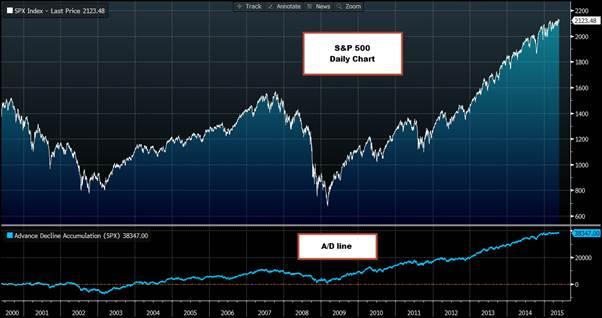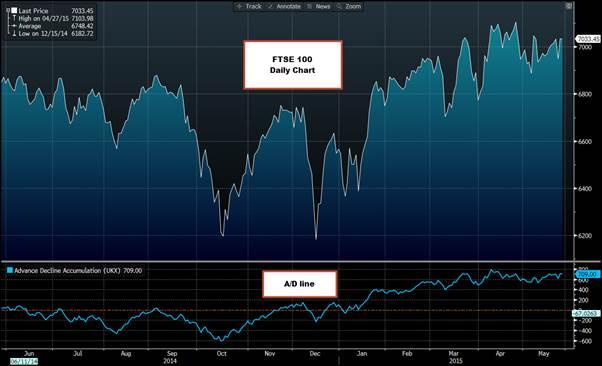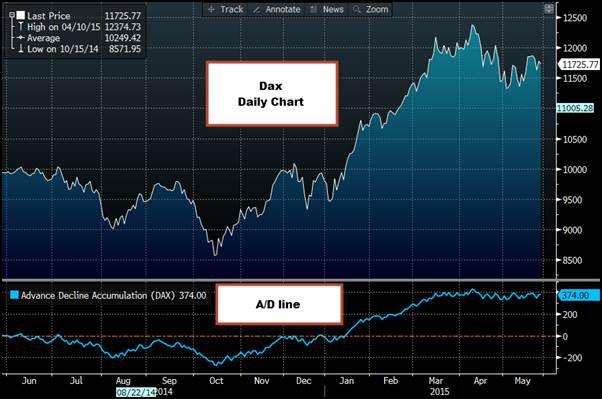![]()
There has been much market speculation of late that the global stock market rally could be running out of steam and stocks may be about to head lower. In fairness, stocks have had a fantastic run; the S&P has been in an uptrend since 2009 and has made record highs. Likewise, the Dax and the FTSE 100 have also reached fresh record territory in recent months, so is it time the markets turned lower?
One way to gauge the strength of a stock market trend is to look at the Advance/ Decline line, otherwise known as the A/D line. The A/D line is the difference between the number of advancing and declining stocks in an index over a set period of time. It is used to determine the strength of a current trend, and to try and determine when a trend will change direction. When the market is advancing but the A/D line is declining this can be a sign that the market rally is losing steam. If the market is advancing at the same time as the A/D line is advancing it is considered the sign of a healthy market rally.
Below we take a look at the S&P 500, the German Dax and the FTSE 100 including their A/D lines, to see if we can find out anything about the strength of their current trends.
1, S&P 500
As you can see, the S&P 500 and the A/D line have mostly been moving in the same direction, however, the A/D line has started to level out in recent sessions. This is worth noting as it suggests that the market could be about to embark on a period of consolidation. We don’t know how the market will react after a period of horizontal movement – will it continue in its uptrend, or will it turn lower? Due to this, we will be watching the A/D line closely in the coming days and weeks, and if it starts to turn lower then the S&P 500’s price action could follow suit.
2, FTSE 100
Similar to the S&P 500, the FTSE 100’s A/D line has also levelled off. The difference here is that it peaked in April, at the same time as the FTSE 100 made a record high. This suggests a couple of things: 1, the FTSE 100 may have already peaked on 27th April at 7,103, 2, the period of consolidation has already begun for the FTSE 100, 3, the next big move for the FTSE 100 could happen sooner than it does for the S&P 500. If the A/D line turns south anytime soon, FTSE 100 traders should have their hard hats at the ready.
3, The Dax
As with the S&P 500 and the FTSE 100, the Dax’s A/D line also suggests that the index is in a period of consolidation. It has been moving sideways since March, but the range of its A/D line is smaller than the range of the FTSE 100’s A/D line, suggesting that this index is happy to stay at a relatively high level for now. Whenever the A/D line moves sideways it is always worth watching it closely to see if it heads south, suggesting a change in trend could be imminent. For now, the A/D line supports the Dax remaining in its current range.
Conclusions:
Our A/D analysis does not suggest that the markets will change direction any time soon.
The S&P 500 still has the strongest uptrend out of all the indices that we looked at.
Although the S&P 500 has the strongest uptrend, the A/D line has started to level off suggesting that we could encounter a period of consolidation.
The FTSE 100 has been in consolidation for the longest amount of time. Due to this, it is worth watching the FTSE 100 as it could be one of the first indices to change direction. If this happens, we would expect to see the A/D line head lower first.
The Dax’s A/D line is also flat-lining, which suggests that the Dax may continue to move sideways for the short term.
Overall, market Sentiment remains fairly strong, but it has lost its oomph of late which suggests that a prolonged period of consolidation could be on the cards during the summer months.
CFD’s, Options and Forex are leveraged products which can result in losses that exceed your initial deposit. These products may not be suitable for all investors and you should seek independent advice if necessary.
Recommended Content
Editors’ Picks
AUD/USD jumps above 0.6500 after hot Australian CPI data

AUD/USD extended gains and recaptured 0.6500 in Asian trading, following the release of hotter-than-expected Australian inflation data. The Australian CPI rose 1% in QoQ in Q1 against 0.8% forecast, providing extra legs to the Australian Dollar upside.
USD/JPY hangs near 34-year high at 154.88 as intervention risks loom

USD/JPY is sitting at a multi-decade high of 154.88 reached on Tuesday. Traders refrain from placing fresh bets on the pair as Japan's FX intervention risks loom. Broad US Dollar weakness also caps the upside in the major. US Durable Goods data are next on tap.
Gold price cautious despite weaker US Dollar and falling US yields

Gold retreats modestly after failing to sustain gains despite fall in US Treasury yields, weaker US Dollar. XAU/USD struggles to capitalize following release of weaker-than-expected S&P Global PMIs, fueling speculation about potential Fed rate cuts.
Crypto community reacts as BRICS considers launching stablecoin for international trade settlement

BRICS is intensifying efforts to reduce its reliance on the US dollar after plans for its stablecoin effort surfaced online on Tuesday. Most people expect the stablecoin to be backed by gold, considering BRICS nations have been accumulating large holdings of the commodity.
US versus the Eurozone: Inflation divergence causes monetary desynchronization

Historically there is a very close correlation between changes in US Treasury yields and German Bund yields. This is relevant at the current juncture, considering that the recent hawkish twist in the tone of the Fed might continue to push US long-term interest rates higher and put upward pressure on bond yields in the Eurozone.


